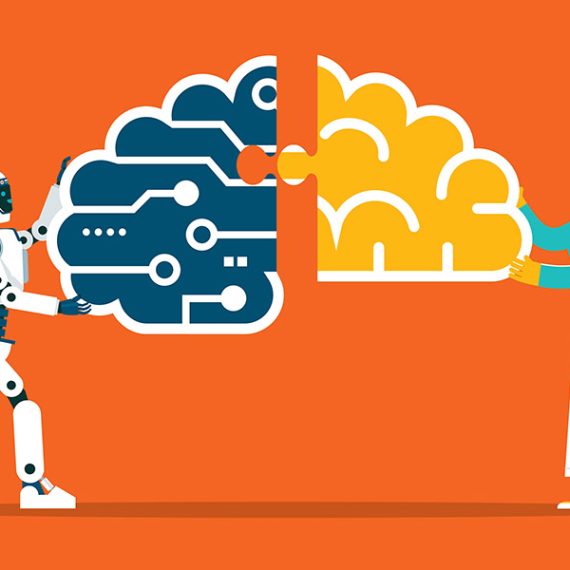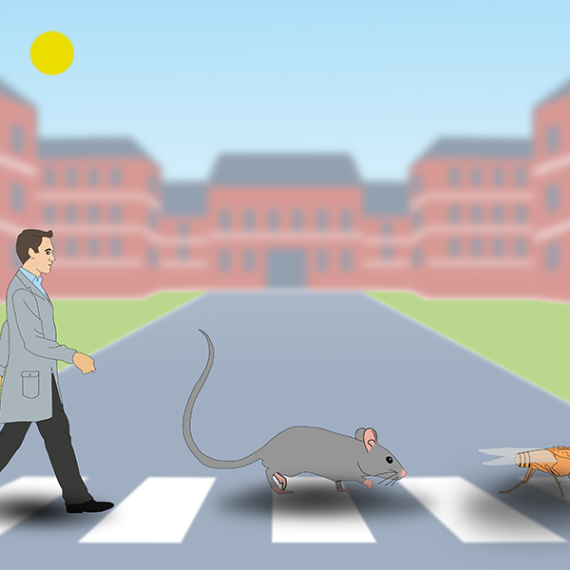Engineering intelligence
The Center for Brains, Minds, and Machines is blending computation, neuroscience, and cognition to build smarter machines and reveal the secrets of human intelligence.

Go is an ancient board game that demands not only strategy and logic, but intuition, creativity, and subtlety—in other words, it’s a game of quintessentially human abilities. Or so it seemed, until Google’s DeepMind AI program, AlphaGo, roundly defeated the world’s top Go champion.
But ask it to read social cues or interpret what another person is thinking and it wouldn’t know where to start. It wouldn’t even understand that it didn’t know where to start. Outside of its game-playing milieu, AlphaGo is as smart as a rock.
“The problem of intelligence is the greatest problem in science,” says Tomaso Poggio, Eugene McDermott Professor of Brain and Cognitive Sciences at the McGovern Institute. One reason why? We still don’t really understand intelligence in ourselves.
Right now, most advanced AI developments are led by industry giants like Facebook, Google, Tesla and Apple, with an emphasis on engineering and computation, and very little work in humans. That has yielded enormous breakthroughs including Siri and Alexa, ever-better autonomous cars and AlphaGo.
But as Poggio points out, the algorithms behind most of these incredible technologies come right out of past neuroscience research–deep learning networks and reinforcement learning. “So it’s a good bet,” Poggio says, “that one of the next breakthroughs will also come from neuroscience.”
Five years ago, Poggio and a host of researchers at MIT and beyond took that bet when they applied for and won a $25 million Science and Technology Center award from the National Science Foundation to form the Center for Brains, Minds and Machines. The goal of the center was to take those computational approaches and blend them with basic, curiosity-driven research in neuroscience and cognition. They would knock down the divisions that traditionally separated these fields and not only unlock the secrets of human intelligence and develop smarter AIs, but found an entire new field—the science and engineering of intelligence.
A collaborative foundation
CBMM is a sprawling research initiative headquartered at the McGovern Institute, encompassing faculty at Harvard, Johns Hopkins, Rockefeller and Stanford; over a dozen industry collaborators including Siemens, Google, Toyota, Microsoft, Schlumberger and IBM; and partner institutions such as Howard University, Wellesley College and the University of Puerto Rico. The effort has already churned out 397 publications and has just been renewed for five more years and another $25 million.
For the first few years, collaboration in such a complex center posed a challenge. Research efforts were still divided into traditional silos—one research thrust for cognitive science, another for computation, and so on. But as the center grew, colleagues found themselves talking more and a new common language emerged. Immersed in each other’s research, the divisions began to fade.
“It became more than just a center in name,” says Matthew Wilson, associate director of CBMM and the Sherman Fairchild Professor of Neuroscience at MIT’s Department of Brain and Cognitive Sciences (BCS). “It really was trying to drive a new way of thinking about research and motivating intellectual curiosity that was motivated by this shared vision that all the participants had.”
New questioning
Today, the center is structured around four interconnected modules grounded around the problem of visual intelligence—vision, because it is the most understood and easily traced of our senses. The first module, co-directed by Poggio himself, unravels the visual operations that begin within that first few milliseconds of visual recognition as the information travels through the eye and to the visual cortex. Gabriel Kreiman, who studies visual comprehension at Harvard Medical School and Children’s Hospital, leads the second module which takes on the subsequent events as the brain directs the eye where to go next, what it is seeing and what to pay attention to, and then integrates this information into a holistic picture of the world that we experience. His research questions have grown as a result of CBMM’s cross-disciplinary influence.
Leyla Isik, a postdoc in Kreiman’s lab, is now tackling one of his new research initiatives: social intelligence. “So much of what we do and see as humans are social interactions between people. But even the best machines have trouble with it,” she explains.
To reveal the underlying computations of social intelligence, Isik is using data gathered from epilepsy patients as they watch full-length movies. (Certain epileptics spend several weeks before surgery with monitoring electrodes in their brains, providing a rare opportunity for scientists to see inside the brain of a living, thinking human). Isik hopes to be able to pick out reliable patterns in their neural activity that indicate when the patient is processing certain social cues such as faces. “It’s a pretty big challenge, so to start out we’ve tried to simplify the problem a little bit and just look at basic social visual phenomenon,” she explains.
In true CBMM spirit, Isik is co-advised by another McGovern investigator, Nancy Kanwisher, who helps lead CBMM’s third module with BCS Professor of Computational Cognitive Science, Josh Tenenbaum. That module picks up where the second leaves off, asking still deeper questions about how the brain understands complex scenes, and how infants and children develop the ability to piece together the physics and psychology of new events. In Kanwisher’s lab, instead of a stimulus-heavy movie, Isik shows simple stick figures to subjects in an MRI scanner. She’s looking for specific regions of the brain that engage only when the subjects view the “social interactions” between the figures. “I like the approach of tackling this problem both from very controlled experiments as well as something that’s much more naturalistic in terms of what people and machines would see,” Isik explains.
Built-in teamwork
Such complementary approaches are the norm at CBMM. Postdocs and graduate students are required to have at least two advisors in two different labs. The NSF money is even assigned directly to postdoc and graduate student projects. This ensures that collaborations are baked into the center, Wilson explains. “If the idea is to create a new field in the science of intelligence, you can’t continue to support work the way it was done in the old fields—you have to create a new model.”
In other labs, students and postdocs blend imaging with cognitive science to understand how the brain represents physics—like the mass of an object it sees. Or they’re combining human, primate, mouse and computational experiments to better understand how the living brain represents new objects it encounters, and then building algorithms to test the resulting theories.
Boris Katz’s lab is in the fourth and final module, which focuses on figuring out how the brain’s visual intelligence ties into higher-level thinking, like goal planning, language, and abstract concepts. One project, led by MIT research scientist Andrei Barbu and Yen-Ling Kuo, in collaboration with Harvard cognitive scientist Liz Spelke, is attempting to uncover how humans and machines devise plans to navigate around complex and dangerous environments.
“CBMM gives us the opportunity to close the loop between machine learning, cognitive science, and neuroscience,” says Barbu. “The cognitive science informs better machine learning, which helps us understand how humans behave and that in turn points the way toward understanding the structure of the brain. All of this feeds back into creating more capable machines.”
A new field
Every summer, CBMM heads down to Woods Hole, Massachusetts, to deliver an intensive crash course on the science of intelligence to graduate students from across the country. It’s one of many education initiatives designed to spread CBMM’s approach and key to the goal of establishing a new field. The students who come to learn from these courses often find it as transformative as the CBMM faculty did when the center began.
Candace Ross was an undergraduate at Howard University when she got her first taste of CBMM at a summer course with Kreiman trying to model human memory in machine learning algorithms. “It was the best summer of my life,” she says. “There were so many concepts I didn’t know about and didn’t understand. We’d get back to the dorm at night and just sit around talking about science.”
Ross loved it so much that she spent a second summer at CBMM, and is now a third-year graduate student working with Katz and Barbu, teaching computers how to use vision and language to learn more like children. She’s since gone back to the summer programs, now as a teaching assistant. “CBMM is a research center,” says Ellen Hildreth, a computer scientist at Wellesley College who coordinates CBMM’s education programs. “But it also fosters a strong commitment to education, and that effort is helping to create a community of researchers around this new field.”
Quest for intelligence
CBMM has far to go in its mission to understand the mind, but there is good reason to believe that what CBMM started will continue well beyond the NSF-funded ten years.
This February, MIT announced a new institute-wide initiative called the MIT Intelligence Quest, or MIT IQ. It’s a massive interdisciplinary push to study human intelligence and create new tools based on that knowledge. It is also, says McGovern Institute Director Robert Desimone, a sign of the institute’s faith in what CBMM itself has so far accomplished. “The fact that MIT has made this big commitment in this area is an endorsement of the kind of view we’ve been promoting through CBMM,” he says.
MIT IQ consists of two linked entities: “The Core” and “The Bridge.” CBMM is part of the Core, which will advance the science and engineering of both human and machine intelligence. “This combination is unique to MIT,” explains Poggio, “and is designed to win not only Turing but also Nobel prizes.”
And more than that, points out BCS Department Head Jim DiCarlo, it’s also a return to CBMM’s very first mission. Before CBMM began, Poggio and a few other MIT scientists had tested the waters with a small, Institute-funded collaboration called the Intelligence Initiative (I^2), that welcomed all types of intelligence research–even business and organizational intelligence. MIT IQ re-opens that broader door. “In practice, we want to build a bigger tent now around the science of intelligence,” DiCarlo says.
For his part, Poggio finds the name particularly apt. “Because it is going to be a long-term quest,” he says. “Remember, if I’m right, this is the greatest problem in science. Understanding the mind is understanding the very tool we use to try to solve every other problem.”




